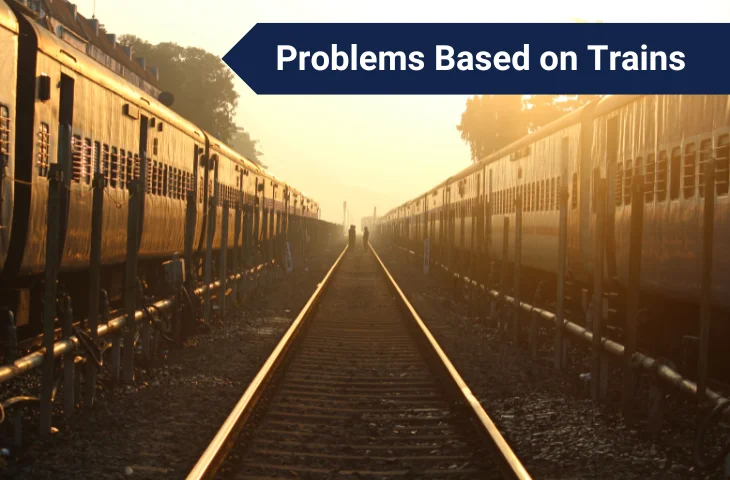In this article, we’ll explore one of the most frequently asked topics in Quantitative Aptitude Problems Based on Trains. These questions test your understanding of relative speed, time, and distance with a practical twist. In this blog we have provided short notes, formulas, quick tricks, types of questions, solved examples from recent exams to boost your preparation for SSC, Banking, RRB, and State-level exams.
What Is Problems Based on Trains in Quantitative Aptitude?
“Problems Based on Trains” involve scenarios where one or more trains cover distances or cross objects like poles, platforms, or other trains. These questions apply fundamental concepts of time, speed, and distance, often using the relative speed concept.
These questions are popular because they:
- Are time-bound and measurable
- Test basic arithmetic and logical interpretation
- Appear with slight variations in multiple exams
Skills Required:
- Basic Speed-Time-Distance understanding
- Logical application of relative speed
- Visualization of crossing events (train-pole, train-platform, train-train)
Why Is Problems Based on Trains Important in Competitive Exams?
Understanding this topic is crucial as it often appears in Tier 1 and Prelims rounds. With the right tricks and formulas, these questions can be solved in under a minute.
| Exam | No. of Questions | Difficulty |
| SSC CGL / CHSL | 1–2 | Easy |
| IBPS PO / SBI PO | 1–2 | Moderate |
| RRB NTPC / Group D | 1 | Easy |
| State PSC / Police | 1–2 | Moderate |
Problems Based on Trains Quantitative Aptitude Short Notes
Terms commonly used to solve questions based on this topic are as follows:
| Term | Description |
| Speed | Distance covered per unit time (m/s or km/h) |
| Relative Speed | Speed difference (opposite direction: add; same direction: subtract) |
| Train crossing pole | Distance = Length of the train |
| Train crossing platform | Distance = Length of train + platform |
| Train crossing another train | Distance = Sum of lengths of both trains |
| Conversion | 1 km/h = 5/18 m/s and 1 m/s = 18/5 km/h |
Quick Revision Summary for Problems Based on Trains
Concepts commonly used to solve Problems on Trains are as follows:
| Concept | Details |
| Relative Speed – Opposite | Speed = A + B |
| Relative Speed – Same | Speed = A – B |
| Time to Cross a Pole | Time = Train Length / Speed |
| Time to Cross a Platform | Time = (Train + Platform Length) / Speed |
| Train Speed Conversion | km/h to m/s → × 5/18 |
| Two Trains Cross Each Other | Time = (Length1 + Length2) / Relative Speed |
What Are the Types of Problems Based on Trains Questions in Quantitative Aptitude?
Different types of questions asked in exams include:
- Direct Length-Speed-Time questions – Basic type where train crosses pole or platform.
- Puzzle-based train questions – Speed and distance given indirectly, need multi-step logic.
- Relative speed with two trains – Train overtaking or crossing another.
- Mixed-concept – Combines train with time zones, unit conversion, or platform width.
Problems Based on Trains Formulas for Quantitative Aptitude
These formulas are your time-savers:
- Speed = Distance / Time
- Time = Distance / Speed
- Relative Speed (Same Direction) = |Speed1 – Speed2|
- Relative Speed (Opposite Direction) = Speed1 + Speed2
- Convert km/h to m/s = Multiply by 5/18
- Convert m/s to km/h = Multiply by 18/5
Example: A train of length 200 m moving at 54 km/h takes how much time to pass a pole?
Convert speed = 54×518=1554 \times \frac{5}{18} = 1554×185=15 m/s
Time = 20015≈13.33\frac{200}{15} \approx 13.3315200≈13.33 sec
Problems Based on Trains Tricks for SSC CGL and Other Exams
Use these smart tricks to save time during exams:
- Always convert km/h to m/s before using formulae
- If train crosses a pole, use only train length
- If train crosses platform, add both lengths
- Use Relative Speed logic when 2 trains are moving
- Draw a mini-diagram for crossing-type questions
- Check units carefully – mix-up between meters and km = silly mistakes
- Use approximation when options are far apart
Solved Problems Based on Trains Questions from 2024–25 Exams
Here are some recent questions with answers and detailed explanations:
Question 1:
(SSC CHSL 2024 Tier 1 – Memory-Based)
A 240 m long train crosses a pole in 12 seconds. What is its speed?
- Solution:
Speed = 240 / 12 = 20 m/s = 20 × 18/5 = 72 km/h
Question 2:
(IBPS Clerk Prelims 2024 – Mock)
A 300 m train crosses a platform 200 m long in 25 seconds. Find its speed.
- Solution:
Total distance = 300 + 200 = 500 m
Speed = 500 / 25 = 20 m/s = 72 km/h
Question 3:
(RRB NTPC 2024 Shift 2 – Memory-Based)
Two trains of lengths 250 m and 150 m move in opposite directions at 54 km/h and 36 km/h. How long will they take to cross each other?
- Solution:
Relative Speed = 54 + 36 = 90 km/h = 25 m/s
Total length = 250 + 150 = 400 m
Time = 400 / 25 = 16 seconds
Problems Based on Trains Concepts for Bank Exams
In IBPS and SBI exams, train problems often include coded data or reverse order logic. For example:
Train A is twice as fast as Train B. They cross each other in 20 seconds when moving in opposite directions. Length of Train B is 150 m. Find length of Train A.

Such questions test conceptual clarity and logical thinking, not just formula application.
Common Mistakes to Avoid while Solving Problems Based on Trains
While solving train-based questions, candidates must keep the below points in mind:
- Wrong Unit Conversion – Always convert km/h to m/s or vice versa correctly.
- Ignoring Object Length – Platform and second train’s length must be added.
- Wrong Use of Relative Speed – Direction matters. Add for opposite, subtract for same.
- Skipping Diagram Sketching – Visualizing improves accuracy in crossing cases.
- Guessing Without Calculation – These are calculative but easy with correct method.
FAQs
Direct crossing, platform-based, two-train relative speed, and mixed-type time-distance problems.
Yes, especially in mains-level IBPS and SBI exams, often in coded or logical formats.
Multiply by 5/18 to convert km/h to m/s; multiply by 18/5 for the reverse.
Add lengths of train and platform, then divide by speed to get time.
- Punjab and Sind Bank LBO Interview Result 2025 Out, Download PDF
- SSC CGL Tier 2 Previous Year Paper, Download Free PDF
- SSC CGL 2025 Tier 1 Question Papers, Shift-Wise PYPs, Download PDFs
- SSC GD Previous Year Question Papers & Solutions, Download Free PDFs
- SSC CHSL Previous Year Question Papers with Solutions, Download Free PDFs
- SSC MTS Previous Year Question Papers & Solutions, Download PDFs

Hi, I’m Aditi. I work as a Content Writer at Oliveboard, where I have been simplifying exam-related content for the past 4 years. I create clear and easy-to-understand guides for JAIIB, CAIIB, and UGC exams. My work includes breaking down notifications, admit cards, and exam updates, as well as preparing study plans and subject-wise strategies.
My goal is to support working professionals in managing their exam preparation alongside a full-time job and to help them achieve career growth.
